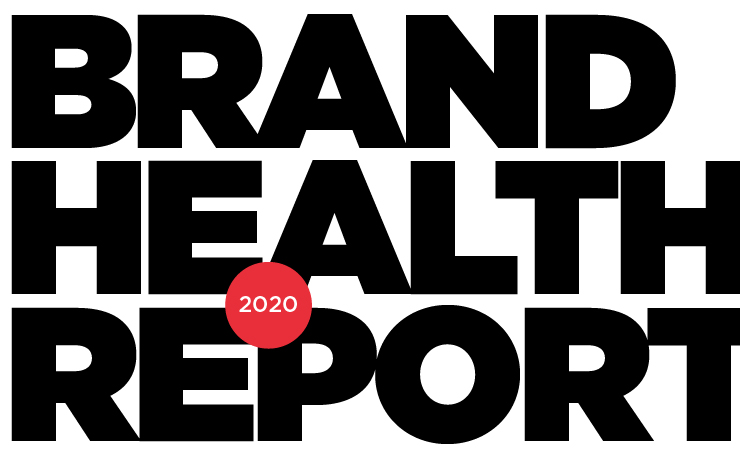
Hired's 4th Annual 'Global Brand Health Report'
Download full report PDF here
An exclusive look at which companies tech talent want to work for and what drives them to take a new jobToday’s most successful companies are the ones that realize their people are their most important asset, and that attracting great talent requires a strong employer brand. A company with a poor reputation could be building the most innovative product, exceed their earnings goals every quarter and continue to lose out on top candidates to a competitor with a stronger positive employer brand that’s more appealing to tech talent.
Related: Hired’s 2022 List of Top Tech Employers
At Hired, we’re always looking for ways to empower companies to get the edge they need to attract the world’s top tech talent, and that all boils down to understanding what these candidates look for in a desirable employer.
To better understand what drives tech talent to consider taking a new job, we surveyed more than 4,100 tech professionals on our platform to find out which companies they want to work for both in their respective city and globally.
We’ve also taken a pulse on what motivates candidates to take that recruiter call, leave their current role and how companies can strategically approach their employer brand to close top candidates, faster.
Section 1#CareerGoals: The world’s most desirable employers
We asked thousands of software developers, product managers, designers and data scientists to rank the companies they’d most like to work for. Here’s how they stacked up:

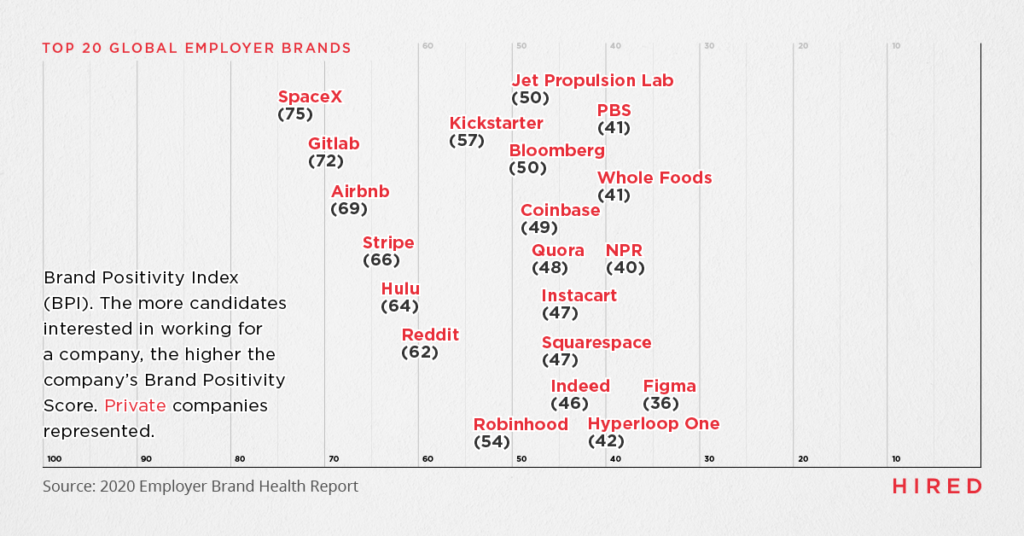
Think of some of the most well known companies in the world: Amazon, Apple, Shopify. Many of them are not only known for their products or services, but the cities they have influenced since becoming prominent household names.
This year, for the fourth consecutive year in a row Shopify topped the list in Toronto, Atlassian beat out Indeed in Austin and Hulu outranked SpaceX in Los Angeles.
City Champions

The way a company is perceived in its own backyard matters just as much as its global reputation. That’s why we asked tech professionals to weigh in on which companies in their current city they want to work for most, because despite the shift we’ve seen toward more long-term remote work, local reputation is still important for attracting great talent.
For the fourth consecutive year Google and Shopify reign supreme as the top employers in the SF Bay Area and Toronto respectively, while media companies continue to make the list in markets like New York, Washington D.C., and London.
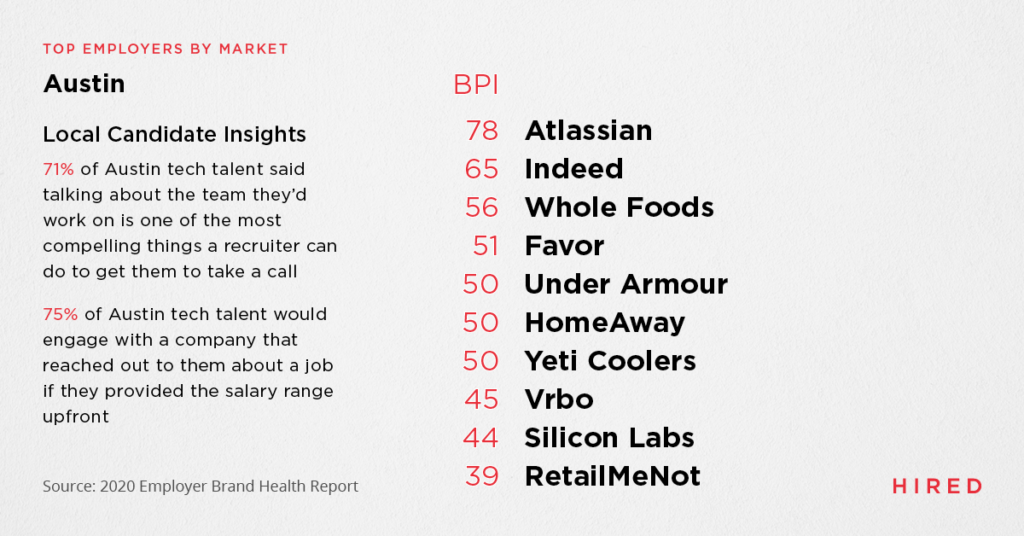
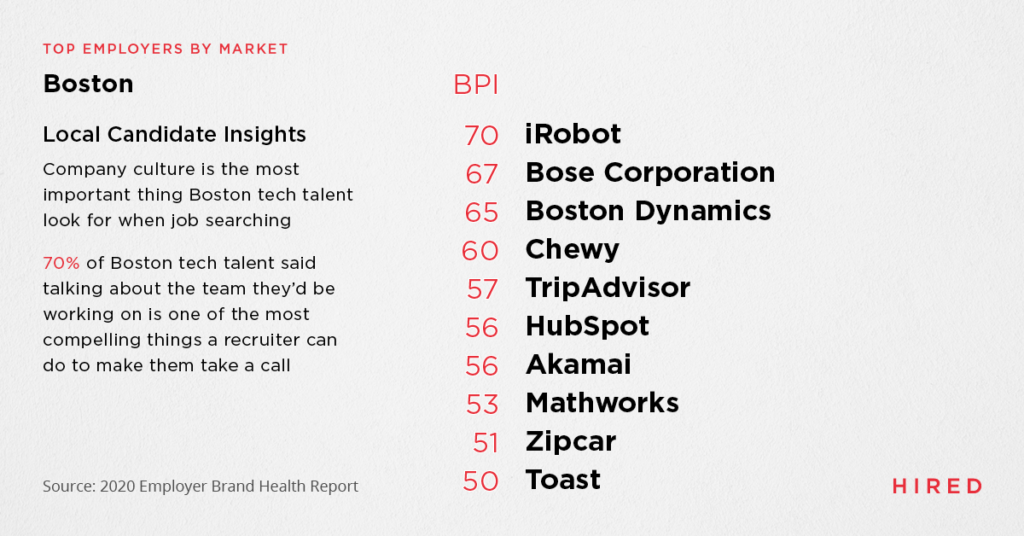

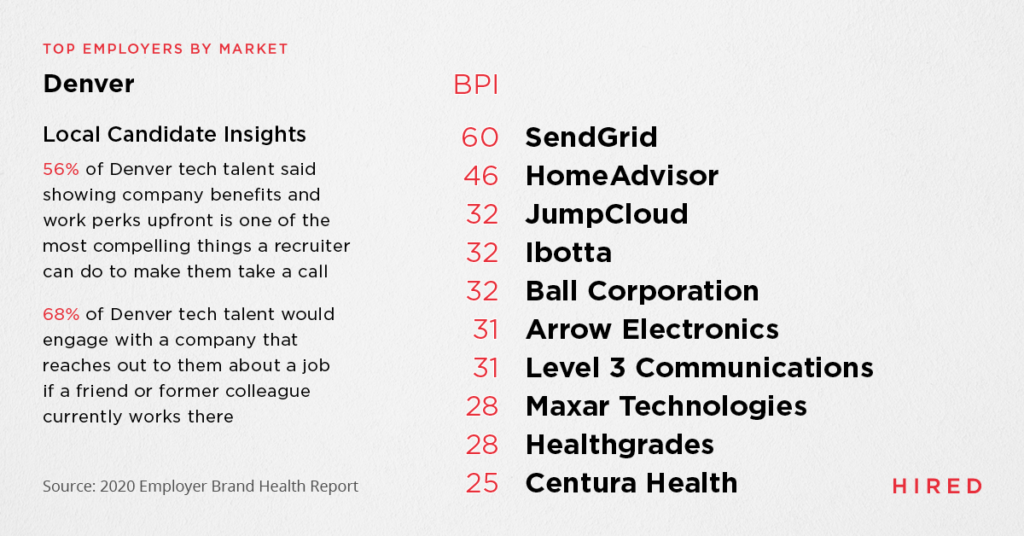

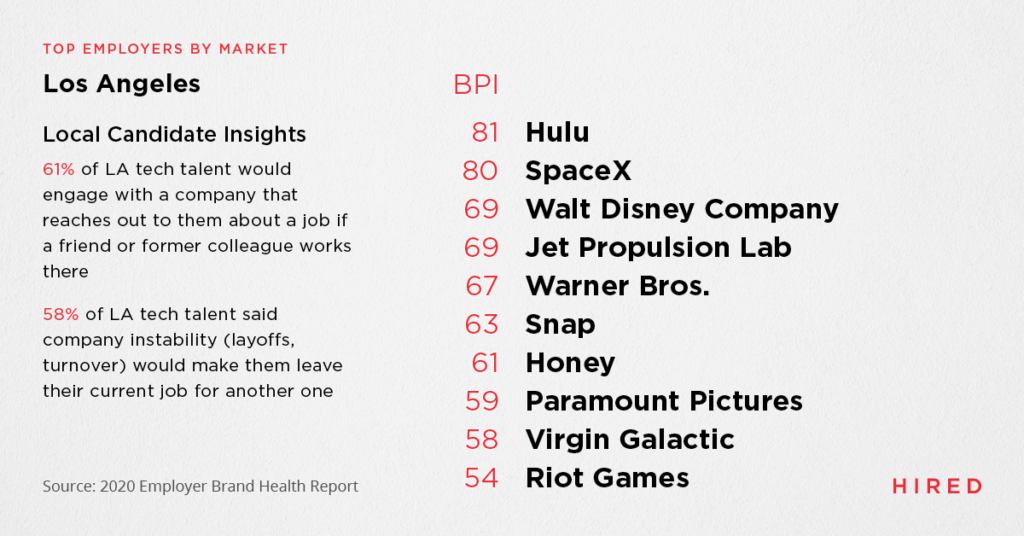


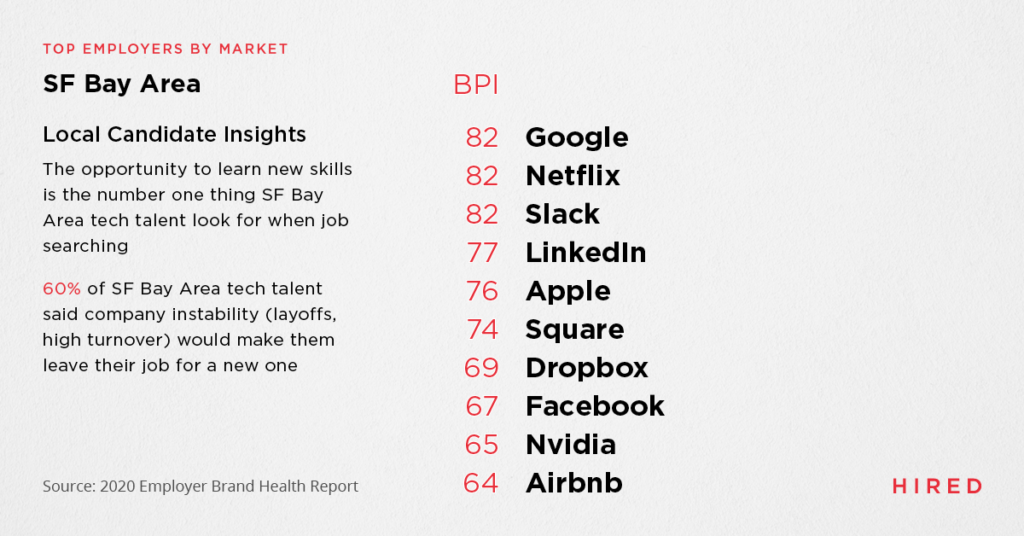
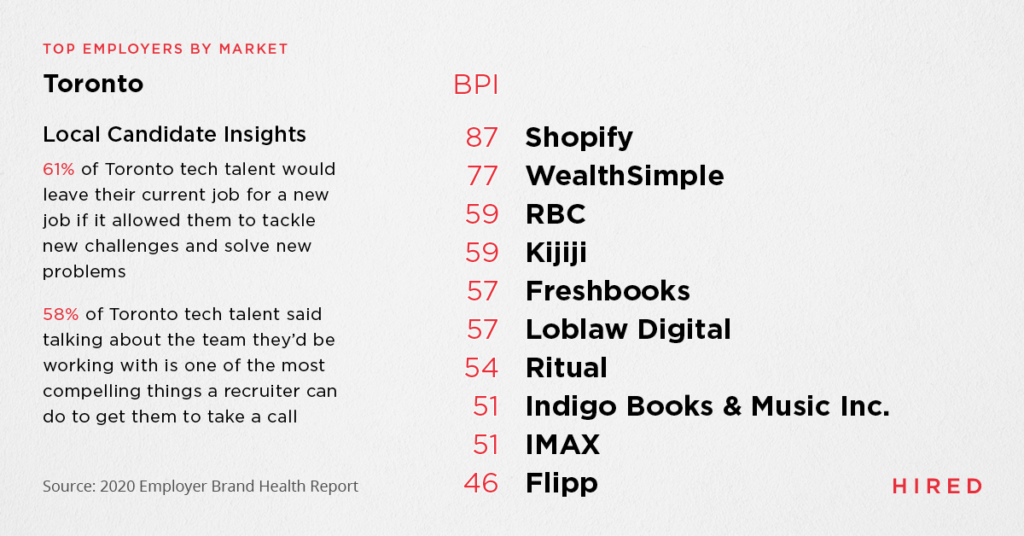
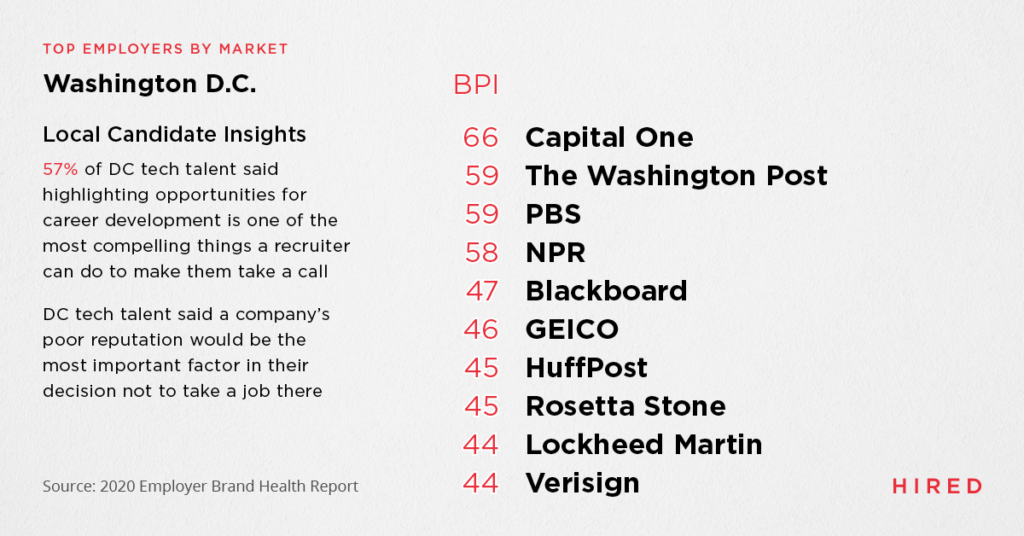
Download full report PDF here
Section 2 Insider look on what makes tech talent tick: Preferences & motivatorsCompanies can’t afford to be complacent on diversity
As racial inequality and injustice has taken center stage in the U.S. this year, it’s forced companies across the globe to examine their commitment to diversity at every level of their organization.
From their talent acquisition strategy to ensuring that diverse talent feels supported in an inclusive work culture, companies should be taking a well-rounded approach to fostering an environment where people from all walks of life can thrive.
And that starts with understanding how different groups in the workforce have different preferences. For example, our recent Compensation Trends Report found that age plays a key role in whether a candidate would accept a lower salary in exchange for permanent remote work, with 37% of tech talent aged 45 and older saying they would, compared to just 28% of tech professionals under age 25.
Our data from tech talent shows this is critical as employers think about attracting candidates, as 64% of survey respondents said a company’s commitment to diversity, equity and inclusion (DEI) would have a strong or very strong impact on their decision to take a job.
When it comes to demonstrating that commitment, nearly half (49%) of the tech talent we spoke with said providing transparent salary data for every role to ensure equitable pay is the most important thing employers can do.
Transparency is key to showing commitment to DEISupporting your diversity goals
Our Hired marketplace empowers both candidates and employers with features to help mitigate bias and ensure equitable pay.
How? When a candidate creates a profile on Hired, we help them understand what salary they should expect for a specific role by providing them with a bell curve that shows the average salary for that role so they can compare it to what they had in mind.
At Hired we’re firm believers in skill-based hiring and we have several features on our platform in place to mitigate all forms of bias.
For companies on our platform, we have a bias filter which removes candidate profile pictures and names so that employers can only evaluate candidates based on their skills and experience.
Additionally, when a company is extending an interview request to a candidate (which requires salary details), our Salary Bias Alert feature will notify employers if they are offering a lower salary than they typically do for that position/role, as that’s a clear indication that bias could be impacting the offer.
Politics can play a role in employer brand
The politically-charged state of the nation is also seeping into hiring as candidates are paying closer attention to what their employer stands for and how that association may directly reflect them, with 54% of tech talent saying a company’s CEO’s political views would have a strong or very strong impact on their decision to accept a job.
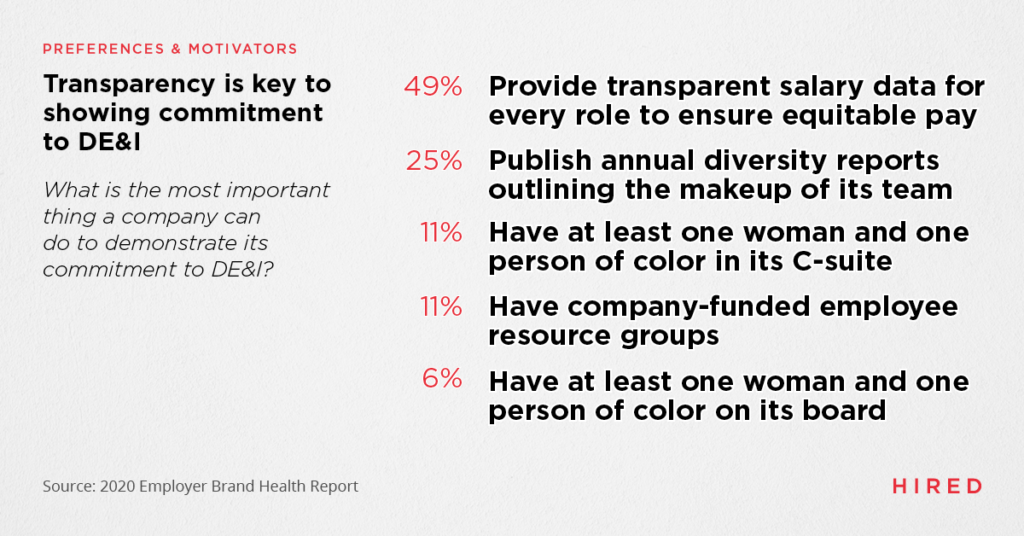
There are other signals that suggest a CEO’s political views impact the employer brand of his or her company. For example, Jack Dorsey, CEO of both Twitter and Square, has been openly vocal about his political views and the adoption of remote work in recent months.
Simultaneously both Twitter and Square saw a boost in their employer brands since our 2019 Brand Health Report. Twitter jumped to number 8 on our list of top global public companies this year, up from number 15 last year, and Square is number 11 on that list, making it for the first time since we’ve started conducting this analysis.
Another example is Stripe, whose CEO Patrick Collison called on corporate America to speak out against the Chinese government’s crimes against Uighur Muslims. Stripe is now number 4 on our list of top private companies, jumping up from number 9 last year.
Remote work opens the doors for more diversity, but Zoom fatigue is realWhen we asked how strongly tech talent agrees with the statement that remote work has the potential to help companies build more diverse workplaces, 45% said very strongly and another 33% said strongly.
So, there’s a clear consensus among tech professionals that the shift toward remote work can lead to more diverse workforces. Insights from our recent Remote Work: Compensation Trends Report suggests this is likely true.
We discovered that 42% of parents have no intention of ever relocating, but they’re very open to remote work, and hiring them for remote roles allows companies to bring parents into their workforce without having to convince them to relocate.
While remote work can help companies increase diversity in the workplace, employers should be conscious of how long they expect team members to spend on video calls.
What is the maximum amount of time you’re willing to spend on video calls each day?
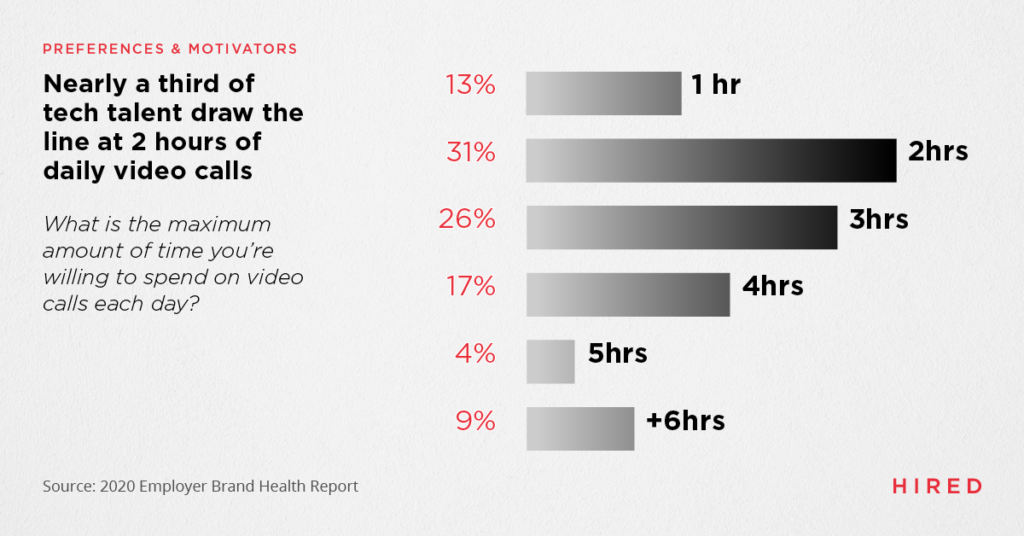
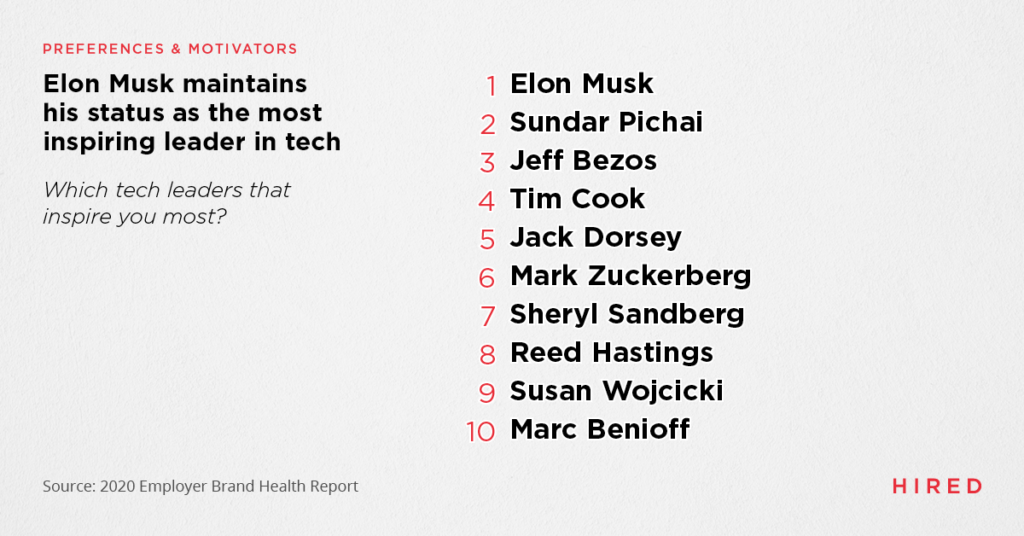
We all know salary matters, but it’s not the only thing that influences a candidate’s decision to accept an offer. Beyond the compensation offered to a prospective new employee, it’s critical that employers understand the other factors that will impact their interest in signing on the dotted line.
From company culture to the projects they’d get to work on, here are the key things tech talent consider when evaluating a new job offer, as well as what would make them leave their current role.
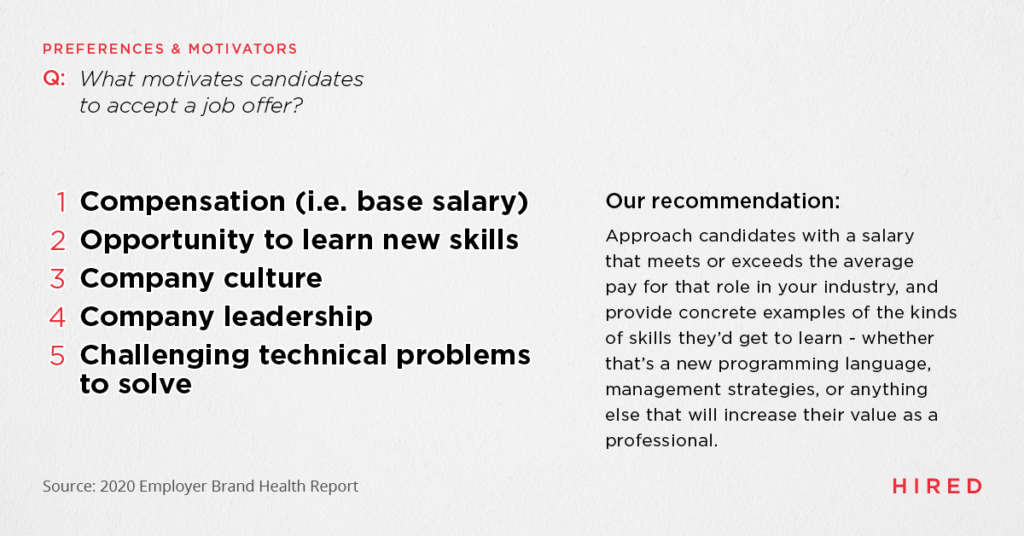
| Stay in the know on salary benchmarks Real data, based on thousands of real job offers. Our annual State of Salaries Report highlights average salaries for tech workers across all major tech hubs. In addition, we dig into specific roles within software engineering in our State of Software Engineers Report to empower tech recruiters with the data-driven insights they need to fill some of the most competitive roles in the market today including DevOps, Full Stack and Gaming Engineers. Read our 2020 State of Salaries Report New – Read our 2021 State of Tech Salaries Report |
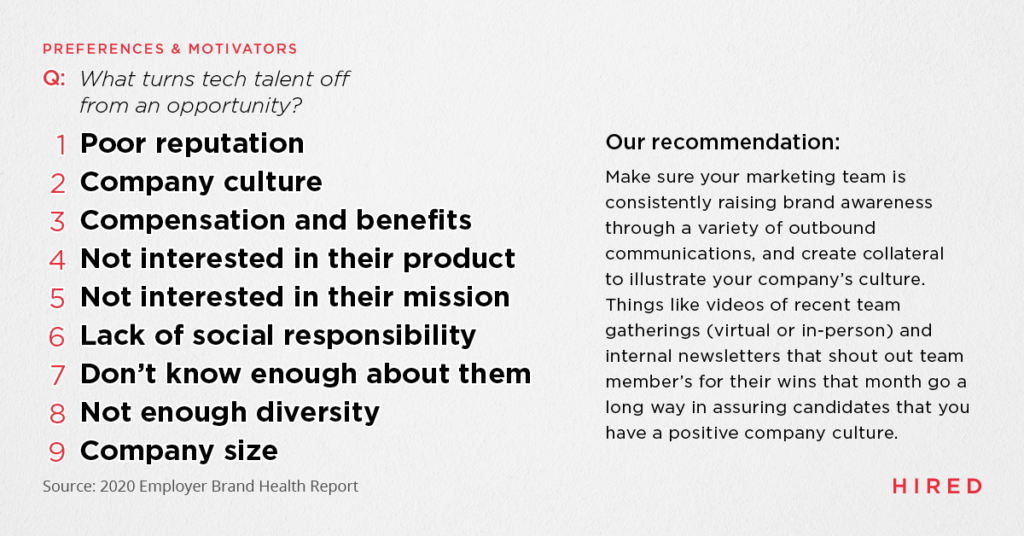
Q: What persuades tech pros to engage with a recruiter?
A: Being tech professionals, it should come as no surprise that tech talent are very interested in what technology they’d get to build and what projects they’d get to work on. They’re also looking for a defined career path and ample opportunity for growth.
- Feature projects/technology they work on = 73%
- Talk about the team I’d be working with = 64%
- Talk about opportunities for career development/training = 54%
Our recommendation: The key takeaway here is that tech talent want to know about the work they’d be doing and who they’d get to do it with, so recruiters should provide details about this when they first reach out. That way candidates can quickly evaluate whether the opportunity aligns with their work interests before moving forward in the interview process, which ensures nobody’s time is wasted on an interview if the candidate isn’t interested in the work.
Q: What makes tech talent engage with a company about a potential opportunity?
A: Transparent salary data and personal connections to the company are key drivers for tech pros to engage with a potential employer, along with the company’s overall brand visibility.
- Salary range upfront = 72%
- A friend or former colleague works there = 56%
- Well known company = 54%
- A personalized message = 52%
- Reputation for being socially responsible = 41%
Our recommendation: Be transparent with salary data from the start, and don’t underestimate the value of a good referral. Asking your colleagues if they know of anyone that could be a fit for open roles is a great way to source potential candidates and should be made part of your standard practice.
Q: What would make you leave your current job for another one?
A: Nearly three quarters of tech talent would be inclined to follow the money and leave their current job for one with a higher base salary. The chance to solve new problems is also a key driver, along with the desire to leave a company if it feels unstable.
- Higher base salary = 74%
- New challenges and problems to solve = 58%
- Company instability (layoffs, high rate of turnover) = 54%
- Not feeling valued by my current manager = 51%
- Higher title = 32%
- Larger team with more resources: 15%
- Written-in Insights: Company with good values, ability to permanently work remotely, a strong engineering culture, work-life balance, their respective technology stack, current employer doesn’t care about diversity
Our recommendation: Keep pay competitive and be transparent with your compensation philosophy and structure to avoid losing great talent to the allure of a higher salary. And while some amount of turnover is inevitable, the way you communicate any staff departures with the rest of the organization is critical for maintaining employee morale and trust. Be transparent from the start, and keep communication lines open.
Dear employers: Tech pros give their advice to companies looking to recruit top tech talent like themselves- “Diversity is not a check box. It’s an ongoing process that requires work and training for managers internally at all levels.”
- “Look for potential, not existing technical skillset. You can learn technical skills on the job, but you can’t make up passion or perseverance.”
- “I want a company that cares about it’s engineering brand (in addition to the overall brand). Invest in community events and meetups that give an opportunity to show off your company’s personality.”
- “Compensate fairly, engage employees, foster a good working environment and interaction with other employees.”
- “Heads up on interview prep, as someone who’s currently interviewing, knowing what’s most important up front would be beneficial.”
- “Compensate fairly, engage employees, foster a good working environment and interaction with other employees.”
- “Evaluate tech aptitude with written coding/architecture challenges that enable candidates to showcase their expertise rather than via interview questions, though a dialog makes sense for evaluating company fit.”
At Hired, our mission is to match tech talent with a job they love at a company they’re excited to work for. To do that effectively, we also need to help employers understand how tech professionals evaluate a company’s employer brand and what they’re looking for in a job.
We publish this report to do just that: arm companies and hiring managers with valuable candidate insights to inform their employer brand strategies.
For example, the findings in this year’s report make it clear that companies must prioritize DE&I, provide transparent salary data upfront, and showcase the projects tech talent would get to work on in order to close top candidates.
It may seem daunting, but investing in your employer brand and tailoring your recruiting process to align with tech professionals’ preferences is essential for attracting and retaining the world’s best talent, which is critical for any company’s long-term success. Prioritize your employer brand today, and you’ll reap the benefits for years to come.
MethodologyHired surveyed more than 4,100 tech professionals, who were provided a list of top local companies that have recently been hiring for tech talent, and asked to rate their level of interest in working for each company. The highest-scoring local brands were added to a larger global list of companies that were then evaluated by a geographically diverse set of tech workers.
To evaluate top brands in local markets, we relied on rankings from local survey respondents only. For global insights, we took both the global rankings and the location of companies’ offices into account.
The Brand Positivity Index combines survey respondents who would ‘love to work’ and ‘might like to work’ at a particular company. Lastly, we asked a series of questions to determine what factors make respondents prefer some companies over others, and what companies can do to make sure they will be considered by top tech talent.
All markets surveyed include: Austin, Boston, Chicago, Denver, London, Los Angeles, New York City, San Francisco, Seattle, Toronto, and Washington, D.C.
Recommended ReadingState of Salaries Report
Tech salary benchmarks and how remote work is impacting talent preferences
Read 2020 Report Read 2021 Report
Compensation Trends Report
An analysis of how compensation and working preferences vary widely depending on location, gender, age and parental status
Read Report
State of Remote Work Report
Unlocking opportunity: From hiring to onboarding, insights that are shaping the way we work
Read Report
Wage Inequality in the Workplace Report
The weight of expectations: Data reveals the gender wage gap in tech and how the expectation gap shapes inequity.
Read Report
State of Software Engineer Report
Data insights reveal most in-demand software engineering roles, trending coding languages and key salary trends across major tech hubs.
Read Report
Hired (Hired.com) is a marketplace that matches tech talent with the world’s most innovative companies. Hired combines intelligent job matching with unbiased career counseling to help people find a job they love. Through Hired, job candidates and companies have transparency into salary offers, competing opportunities and job details. This level of insight is unmatched, making the recruiting process quicker and more efficient than ever before.
Hired was founded in 2012 and is headquartered in San Francisco, with offices in the United States, Canada, France, and the UK. For more information, news, and tips for job candidates and employers, visit Hired’s blog.
Revised Oct. 28, 2021
Related blog posts
Late Stage Companies Winning the War for Talent
Ever wondered how much less seed stage companies pay than late-stage companies with loads of cash?...
VentureBeat: 7 Deadly Sins of Hiring Engineers
VentureBeat has published a guest article by our CEO, Matt Mickiewicz on the most common...
What’s Wrong With The Recruiting Industry
1.) Transparency on financial interests & conflicts. Very few candidates realize how...
5 Stumbling Blocks To Hiring Engineers in Silicon Valley (and NYC)
These mistakes are frequently made by first-time founder/CEOs and seed stage companies…. 1.)...
How Recruiting Can Kill A Start-Up
If your hiring process is taking longer than 10 business days, its broken. You need to be...
How The Founders of Hired Met – INC Magazine
INC Magazine has published an article recounting the story of how the Founders of Hired...

